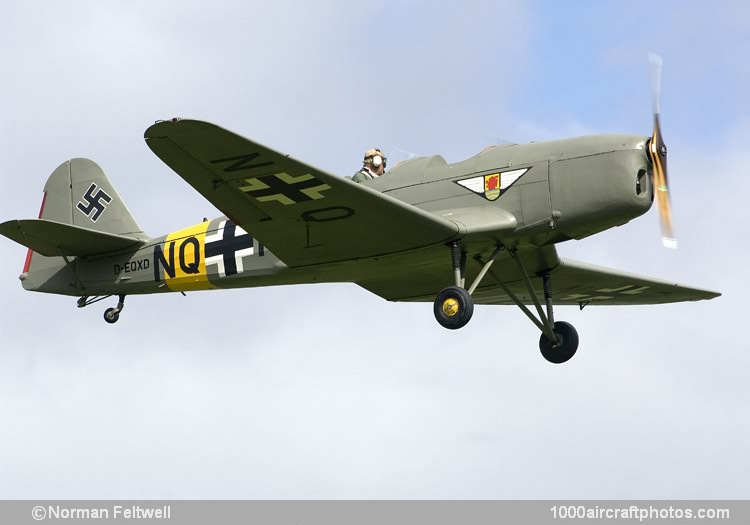A second prototype, the Kl 35 b was followed by the production Kl 35 B, with an 105 hp Hirth HM 504A-2 engine. This type was produced in considerable numbers by Leichtflugzeugbau Klemm GmbH for the clandestine Luftwaffe's training schools and for the Deutscher Luftsport Verband (German Sport Flying Association). A float-equipped Kl 35 BW appeared in 1938, along with the improved Kl 35 D with 80 hp Hirth HM 60R, which was the foremost military version widely used by the Luftwaffe for training throughout WW II.
The Klemm Kl 35 was also built under license in Sweden for the Swedish AF and was exported to Czechoslovakia, Hungary and Romania. In Luftwaffe service the Kl 35 performed many roles, operating on wheels, skis and floats. One aircraft was flown with overwing personnel containers. A number of special aerobatic versions of the Kl 35 were also developed in peacetime. One such, the Super Klemm Kl 35 D Akrobat, was used by West German pilot Josef Hössl for the 1970 World Aerobatics Championships held at Hullavington, England, where his 35-year-old, 160 hp Walter-engined machine performed well against its modem counterparts.
During WW II Hanns Klemm worked on developments of his L 25/Kl 35 series, and marketed the Kl 107 two-seater powered by a 90 hp Continental engine, based on a design completed in 1940 but abandoned in wartime. Design rights to the Klemm were acquired by the Bölkow company and series production of the type as the Bölkow BO 107 began in the late 1950s. The
BO 107C was a three-seater powered by an 150 hp Lycoming. In 1960 a four-seat, 180 hp model, the BO 207 appeared.
The pictured aircraft was built in Böblingen, Germany in 1941, and delivered to the Swedish AF under the military designation Sk 15A (Sk = Skole, School) and serial 5050. Coded 5-180 (later 14-21) it served at the Central Flying School till 1947. On April 5, 1948 it was registered to the Halmstad Flygklubb (aero club) as SE-BGD, subsequent owners were K. Tullberg of Hälsingborg (June 30, 1955), Ljungbyheds Flygklubb (October 1, 1959), and B.L. Johnsson of Ljungby (September 1, 1961). It was withdrawn from use on December 6, 1961 as no longer airworthy.
In 1967 it was sold to the USA where it was restored to airworthiness by Lars de Jounge of Carmel Valley, California, using the wings of the Kl 35 B with c/n 1711 (ex D-EXWF, SE-AKH); first registered N505Q, it was reregistered N5050 on October 9, 1980. It was cancelled from the FAA Register on March 14, 2007, as "exported to the UK". Although based with the Shuttleworth Collection at Old Warden Aerodrome, near Biggleswade, UK, the aircraft was registered in Germany as D-EQXD on August 24, 2007. Since 2010 the aircraft is based in Germany with Quax, an association devoted to historic aircraft."
